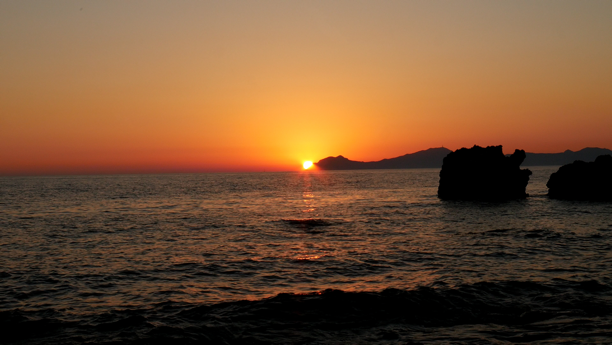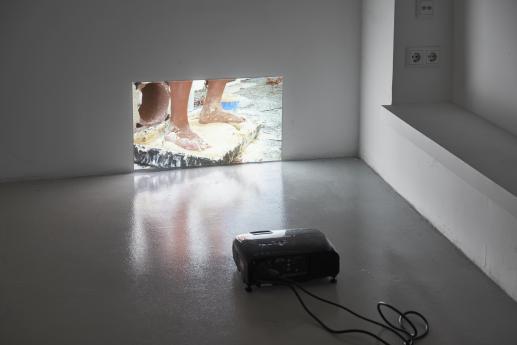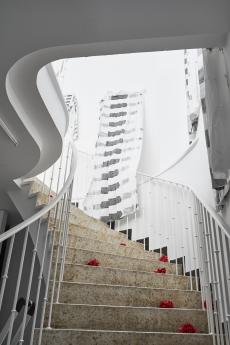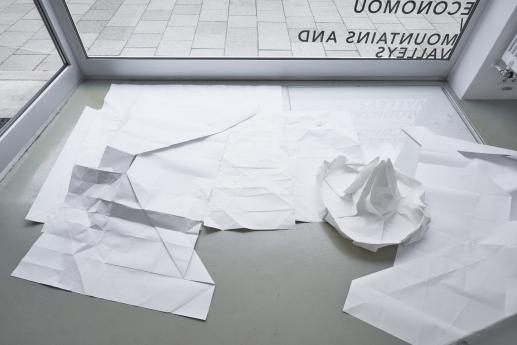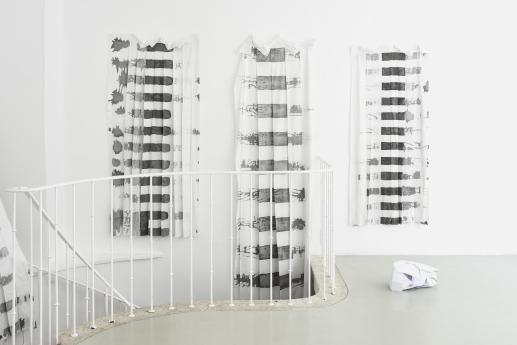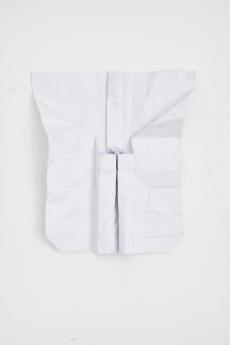DORA ECONOMOU
/
MOUNTAINS AND VALLEYS
10.11 – 12.12.2016
“the scattered tea goes with the leaves and every day a sunset dies: a poet’s extravagance which as quite often mirrors truth but upside down and backward since the mirror’s unwitting manipulator busy in his preoccupation has forgotten that the back of it is glass too: because if they only did, instead of which yesterday’s sunset and yesterday’s tea both are inextricable from the scattered indestructible uninfusable grounds blown through the endless corridors of tomorrow, into the shoes we will have to walk in and even the sheets we will have (or try) to sleep between: because you escape nothing, you free nothing; the pursuer is what is doing the running: no fleeing nor repudiation nor for this moment more even urgency anywhere in the room or outside it either above or below or before or behind the tiny myriad beast sounds and the vast systole and diastole of summer night.” William Faulkner
Dora Economous Arbeit verblüfft mit ihrer intensiven Einfachheit und außergewöhnlichen Klarheit: Totenschädel, die mit einer nahezu kindlichen Herangehensweise platziert wurden, schlicht gefaltete Vorhänge und kunstlose Origami. Sie wurde von den Kunstwerken einer der extremsten Kommentatoren der Moderne, José Guadalupe Posada, einem mexikanischen Graphiker und Kupferstecher aus dem 19. Jahrhunderts, der für seine Darstellungen von Totenschädeln, Calavera und Skelette bekannt war, inspiriert. Calavera sind Repräsentationen des menschlichen Schädels und werden oft an dekorative oder essbaren handangefertigten Schädeln, die entweder aus Zucker oder Lehm gefertigt wurden, angebracht. Sie sind eng mit dem Brauchtum der mexikanischen Feierlichkeiten am Tag der Toten (Día de Muertos) und dem römisch-katholischen Feiertag Allerseelen verwurzelt. Diese Schädel geben sich einem endlosen Danse Macabre hin, welcher die satirische Scharfsinnigkeit und die politische und kulturelle Dringlichkeit eines Kritikers der Moderne erklärt. Auch in der ersten Hälfte des 17. Jahrhunderts, dem niederländischen golden Zeitalter, wurden Totenschädel oftmals in Stillleben porträtiert. Sie weisen visuell auf den Wahnsinn und der Gewalt des Lebens hin und wurden oft mit dem frivolen und opulenten Aspekten des Reichtums in Kontrast gebracht.
Economou verwendet diese Vanitas als Antrieb für ihre Skulpturen, tut dieses jedoch mit einem Hauch von anspruchsvoller Scharfsinnigkeit. Die Papierskulpturen der Künstlerin sind imperfekte und unregelmäßige Multiple, individualisierte Kopien die von einem generischen Original ausgehen. In der Tat, so behauptet Economou, stehen sie eher der ‚expressionistischen’ Domäne nahe. Somit kann der Papierschädel weder als materielle Manifestation der Unvermeidbarkeit des Todes fungieren, noch kann er an die Menschen appellieren sich ihrer Mortalität bewusst zu werden. Tatsächlich müssen diese Totenschädel als Attrappen gesehen werden, die den Betrachter stets dazu ermahnen sich mit Kunst auseinander zu setzen und über sie nachzudenken. Diese Attrappen werden von Economou nahezu verehrt. Wie man zum Beispiel an ihrer Liebe für das traditionelle japanische Origami (von ori = falten + kami = Papier) sehen kann. Diese Technik verwandelt ein flaches quadratisches Stück Papier durch falten und andere skulpturale Techniken in eine vollendete Skulptur. Es ist nicht erlaubt das Papier durch reißen und kleben zu bearbeiten. Das bekannteste Origamimodel ist der japanische Papierkranich, dem Economou mit der Anfertigung von tausenden nachgebildeten Kranichkopien viel Zeit gewidmet hat.
Es muss hier jedoch angebracht werden, dass das Erstellen von endlosen Kopien und Ersatzmodellen typisch für Economous jüngsten Arbeiten ist. Unter anderem ist sie von den kleinen Hügeln, den Fujizuka, Miniaturnachahmungen des Berges Fuji, die während der Edo-Zeit ihren größten Beliebtheitsgrad erreichten, inspiriert. Diese Ersatzhügel können üblicherweise in und um Tokyo herum gefunden werden. Vom Fuße bis zum Gipfel sind sie normalerweise nicht höher als drei Meter und stellen die zehn Stationen des Fuji selbst dar. Pilger denen es nicht möglich war den Fuji selbst zu erzwingen, erstiegen stattdessen einer dieser Miniaturberge. Diese Sitte stellt somit wesentliche Fragen an das Maß und dem Wert den wir der Realität und Authentizität an sich zuschreiben.
Die Arrangements der Künstlerin trotzen dem alteingeschworenen Konzept der Originalität und sogar dem der Komposition, die beide vermeintlich für den Triumph der Schönheit verantwortlich sind, indem sie durch die Tiefen des Formlosen waten. Economous Skulpturen ähneln natürlichen, jedoch ungewöhnlich und asymmetrisch gebildeten Steinformationen, die in China als Stein der Gelehrten oder Stein der Besinnung bekannt sind – sie sind also als Anreiz zum Denken gedacht. Ihre Arbeiten enthüllen jenes Auf- und Eintauchen, jene Denkräume, die sich zwischen dem was dort ist und dem was dort nicht ist auftun. In diesem Zusammenhang stellt sie sich auf die Seite der Denkweise des Orients oder der vorsokratischen Philosophie des antiken Griechenlands, die dem andauernden Prozess einen höheren Stellenwert als dem eigentlichen Resultat einräumen. Der Wandel des Lebens wird allerdings nicht durch das utopische Pathos eines Vertreters der Moderne, sondern durch die bedachten Selbstironie und der allegorischen Skepsis einer zeitgenössischen Künstlerin, enthüllt.
Sotirios Bahtsetzis
“the scattered tea goes with the leaves and every day a sunset dies: a poet’s extravagance which as quite often mirrors truth but upside down and backward since the mirror’s unwitting manipulator busy in his preoccupation has forgotten that the back of it is glass too: because if they only did, instead of which yesterday’s sunset and yesterday’s tea both are inextricable from the scattered indestructible uninfusable grounds blown through the endless corridors of tomorrow, into the shoes we will have to walk in and even the sheets we will have (or try) to sleep between: because you escape nothing, you free nothing; the pursuer is what is doing the running: no fleeing nor repudiation nor for this moment more even urgency anywhere in the room or outside it either above or below or before or behind the tiny myriad beast sounds and the vast systole and diastole of summer night.” William Faulkner
Dora Economou’s work bewilders with its intense simplicity and sublime plainness: skulls fashioned in a child-like manner, plainly folded curtains and artless origami. Economou’s work is inspired by the work of a ferocious commentator of modernity, José Guadalupe Posada, a Nineteenth century Mexican printmaker and engraver, known for the depiction of skulls, calaveras, and skeletons. A calavera is a representation of a human skull and it is often applied to decorative or edible handmade skulls made from either sugar or clay which are used in the Mexican celebration of the Day of the Dead (Día de Muertos) and the Roman Catholic holiday All Souls' Day. These skulls engage in an endless Danse Macabre, which accounts for the satirical acuteness and the political and cultural urgency of a critic of modernity. Skulls are also often visible in still life paintings of the Dutch Golden Age in the first half of the Seventeenth century. They are visual cues of the frenzy and violence of life, which is contrasted with the often frivolous and lush representations of wealth. Economou employs this vanitas motive in her sculptures, however, with a touch of sophisticated wit. The artist’s paper sculptures are just imperfect and irregular multiples, individualized copies of a generic original. As a matter of fact, they appear to be rather ‘expressionistic’ – as Economou maintains. Conversely, the paper skull cannot be taken literally as an actual manifestation of the inevitability of death and as an appeal to consider mortality. In fact, these skulls are rather mock- ups of how art always exhorts the viewer to consider and contemplate. Economou adores this kind of mock-ups. This is visible, for instance, in her love for traditional Japanese origami (from orimeaning "folding", and kami meaning "paper"). This technique transforms a flat sheet square of paper into a finished sculpture through folding and sculpting techniques. No tearing or gluing is allowed. The best-known origami model is the Japanese paper crane, and Economou has devoted some of her time in making thousands of such cranes.
It should be noted that making endless copies and surrogates constitutes a standard practice of the recent work of Economou. She is inspired, for instance, from these small mounds with the name fujizuka, which represent Mount Fuji, and were very popular during the Edo period. These ersatz mountains commonly found in and around Tokyo are usually around three meters high, and replicate the ten stations on Fuji itself, from the foot of the mountain to the summit. Pilgrims who were unable to climb Mount Fuji would ascend one of these surrogates instead. This practice poses a serious question regarding the value of reality and authenticity.
The artist’s arrangements defy the idea of originality or even composition, which supposedly let beauty to triumph through the depths of the formless. Economou’s sculptures resemble rather such naturally shaped rocks of an awkward asymmetry, known in China as scholar stones or viewing stones – an inducement of thinking. Her work renders visible the emerging and immersing, the mental space between there it is and there it is not. In this regard, she sides rather with the way of thinking of the Orient or the Pre-Socratic philosophy in ancient Greek, which values process over outcome. Uncovering the flux of life is done however not with the utopian pathos of a modernist, but with the restricted self-irony and the allegoric scepticism of a contemporary.
Sotirios Bahtsetzis
Dora Economou
/
Biography
Solo Exhibitions
Group Exhibitions
"The Materiality of the Painterly Event" curated by Denys Zacharopoulos, City of Athens Arts Center
"Family Ghosts Calling" / Family Business, New York
"LUSTLANDS AT" / Family Business, New York
"KATATAKTIRIES" / a sculpture potluck at the squatted theatre EBROS, Athens
"A Talent For Trouble" / LORAINI ALIMANTIRI gazonrouze, Athens
"Abstract Further Abstraction" / Greek Art Institute, Athens
"Greek art" / Sem-Art, Monaco
"Artists for Athens Pride II" / the Breeder, Athens
"Strutture Precarie" / San Vito al Tagliamento
"Women Only" / Arbeiten aus der Beltsios Collection, Amfilochia
"Part Time Punks" / DESTE Foundation, Athens
"Drawing Screen" / National Museum of Cinema, Thessaloniki
"Art Fab 'Women in Europe'" / Saint Tropez
"Prospective Sites" / Billboard project, Wien
"New Acquisitions, Intercontinental" / Dakis Ioannou collection, Athens
4th Deste Foundation Prize / Deste Foundation, Athens
